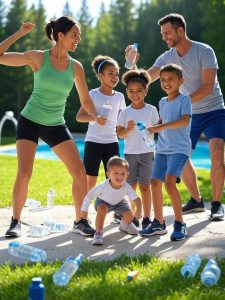
The warmth invites us outdoors, promising long days filled with opportunity. For many, summer signals a break from routine—school lets out, work schedules might ease, and the call of relaxation grows loud. But amidst the barbecues and beach trips, staying fit during these months is more crucial than ever. As a personal and group fitness instructor with over 15 years of experience, I’ve seen firsthand how a commitment to fitness can transform not just individual health but entire family dynamics. This article explores why staying fit in the summer matters, how to make it a family affair, the vital role of hydration, and a variety of active activities to keep everyone moving—all while weaving in practical tips to make it enjoyable and sustainable.
Why Staying Fit in the Summer is Essential
Summer brings unique challenges and opportunities for physical health. The longer days and higher temperatures can lead to increased sedentary behavior—think lounging by the pool or binge-watching shows in air-conditioned comfort. However, maintaining fitness during this season offers numerous benefits that extend beyond the warmer months.
Physical Health Benefits
The human body thrives on consistency. Regular exercise boosts cardiovascular health, strengthens muscles, and improves flexibility—benefits that are critical when summer’s heat can strain the heart and joints. Studies from the American Heart Association suggest that 150 minutes of moderate aerobic activity per week can reduce the risk of heart disease by up to 20%. For me, as someone who’s crafted customized fitness programs for clients over the years, I’ve seen how summer workouts enhance endurance, preparing individuals for the physical demands of outdoor play or travel. The heat also increases the body’s metabolic rate, meaning staying active can aid in weight management when paired with a balanced diet—something I’ve emphasized with clients at Snap Fitness to help them reach their goals.
Mental Health and Energy Boost
Summer can be a season of stress—planning vacations, managing kids’ schedules, or even dealing with seasonal affective disorder in reverse (feeling overwhelmed by too much sunlight). Exercise releases endorphins, the body’s natural mood elevators, reducing anxiety and depression. As a former Division 1 soccer athlete at the University of Arizona, I learned the value of staying active to maintain mental resilience, a lesson I’ve passed on to my fitness groups. Regular movement during summer keeps energy levels high, combating the lethargy that often accompanies heatwaves, and fosters a sense of accomplishment that carries into family life.
Preventing the Summer Slide
For families with children, the “summer slide”—a decline in academic and physical fitness during the break—is a real concern. The Centers for Disease Control and Prevention (CDC) notes that kids can gain weight faster in summer due to reduced structured activity. As a Team Lead in education, I’ve worked to combat this by integrating physical activity into school programs, a strategy that translates beautifully to home life. Keeping fit as a family prevents this slide, ensuring kids return to school healthier and more focused.
Long-Term Health Investment
Summer fitness sets the tone for the year. Habits formed now—consistent exercise, healthy eating, and hydration—lay the foundation for lifelong wellness. My experience mentoring teachers and designing curricula has taught me the power of early intervention, and the same applies to fitness. A summer of activity can reduce the risk of chronic conditions like diabetes and hypertension, benefits I’ve seen in clients who commit to their programs year-round.
Making Fitness a Family Affair
Turning fitness into a family activity transforms it from a chore into a bonding experience. As someone who’s led diverse groups and worked with families as a special education teacher, I’ve learned that inclusivity and fun are key to success. Here’s how to make it work:
Involving Everyone
Every family member, regardless of age or ability, can participate. For young children, simple movements like dancing or tag games work wonders. Teens might enjoy a soccer match—drawing from my Division 1 athletic days—while adults can join in with walking or strength training. I’ve customized fitness programs for clients with varied needs, a skill I apply to ensure grandparents or those with mobility issues can engage through chair exercises or gentle stretching. The goal is participation, not perfection.
Setting Family Goals
Progressive goal-setting, a technique I’ve used with clients at Snap Fitness, is powerful here. Start with a family fitness challenge—say, a 30-day walking goal of 10,000 steps daily. Celebrate milestones with rewards like a movie night, fostering motivation. My experience as a Team Lead has taught me to track progress with data, so use a shared app or chart to monitor steps or activity minutes, making it a team effort.
Creating a Positive Environment
At Snap Fitness, I learned to cultivate a supportive atmosphere, a principle I bring to family fitness. Encourage positive reinforcement—praise effort over outcome—and keep activities fun to avoid burnout. My teaching background helps me mediate sibling rivalries or fatigue, ensuring everyone feels included. Turn workouts into games, like relay races or obstacle courses, to build a culture of success and joy.
Scheduling Family Fitness Time
Consistency is key. As a Team Lead, I’ve managed busy schedules, a skill I apply to family planning. Designate specific times—morning walks or evening bike rides—around everyone’s availability. Flexibility is crucial; if a session is missed, adapt with a quick indoor stretch session. My experience coordinating school events ensures these plans are realistic and sustainable.
Benefits of Family Fitness
Beyond health, family fitness strengthens bonds. Shared activities improve communication and trust, reducing stress—a lesson from my supervisory roles. It also models healthy behaviors for kids, a value I’ve championed in education. Studies show families that exercise together report higher satisfaction, a trend I’ve observed in my fitness groups where camaraderie boosts commitment.
The Importance of Hydration in the Summer
Hydration is the unsung hero of summer fitness, especially given the intense heat we’re experiencing today at 12:48 PM MST on May 19, 2025. As a fitness instructor, I’ve emphasized its role in every program I’ve designed, and its importance cannot be overstated.
Why Hydration Matters
The body loses water rapidly in summer through sweat, particularly during exercise. Dehydration can lead to fatigue, heatstroke, and muscle cramps—risks I’ve mitigated for clients by monitoring their intake. The CDC recommends 8-10 cups of water daily for adults, with an additional 12 ounces per 30 minutes of exercise in hot weather. For families, this need scales with activity levels, especially for kids who dehydrate faster. My experience working with special education students taught me to recognize early signs of dehydration, like irritability, ensuring timely intervention.
Impact on Performance
Proper hydration enhances endurance and strength. A 2% loss in body weight from dehydration can reduce performance by 10-20%, according to the American College of Sports Medicine. As a soccer athlete, I learned this firsthand during Arizona’s scorching practices, a lesson I’ve applied to help clients maintain peak performance. For families, staying hydrated keeps everyone energized for longer play sessions, preventing the mid-afternoon slump.
Health Benefits
Hydration supports kidney function, regulates body temperature, and aids digestion—crucial during summer barbecues. It also flushes toxins, reducing the risk of illness. My role as a Team Lead involved educating parents on health basics, a skill I use to advocate for water over sugary drinks, a common summer pitfall. For kids, adequate hydration improves concentration, bridging the summer slide gap I’ve addressed in schools.
Practical Hydration Tips
- Carry Water: Use reusable bottles for family outings—my fitness groups swear by this habit.
- Flavor Naturally: Add lemon or cucumber for taste, a trick I’ve shared with clients.
- Schedule Intake: Drink every 15-20 minutes during activity, a practice I enforce in my programs.
- Monitor Kids: Watch for dry lips or lethargy, drawing from my special education vigilance.
- Electrolytes: For intense sessions, consider sports drinks, a recommendation I’ve tailored for athletes.
Neglecting hydration can derail fitness goals, a risk I’ve prevented through education and example, making it a cornerstone of my family fitness philosophy.
Great Active Activities to Stay Fit
Summer offers a playground of activities to keep families fit. Drawing from my fitness expertise and love of outdoor engagement, here are some standout options:
1. Swimming
A full-body workout, swimming suits all ages. Laps improve cardio, while water games like Marco Polo build family fun. I’ve designed water-based programs for clients, emphasizing safety and technique. Access local pools or lakes, and aim for 30-minute sessions 3-4 times weekly.
2. Hiking
Arizona’s trails, like those near Gilbert, offer scenic fitness. Start with easy paths, progressing to moderate hikes. My soccer background taught me endurance, a skill I share with groups. Bring water and snacks, targeting 1-2 hours per outing.
3. Biking
Family bike rides strengthen legs and hearts. Use local paths or parks, adjusting distances by age. I’ve led cycling sessions, focusing on safety gear and pacing, recommending 20-40 minutes 2-3 times a week.
4. Soccer or Kickball
Leveraging my Division 1 soccer experience, these games boost agility and teamwork. Set up a backyard pitch or join a community league. I’ve coached kids and adults, suggesting 30-minute games 2-3 times weekly.
5. Yoga or Stretching
Gentle yet effective, outdoor yoga improves flexibility. I’ve customized stretching routines for clients, ideal for mornings or evenings. Aim for 20-30 minutes daily, using free online guides.
6. Gardening
A functional workout, gardening builds strength and mindfulness. My Team Lead role involved community projects, and I’ve encouraged clients to dig and plant. Spend 1-2 hours weekly, reaping physical and edible rewards.
7. Dance Parties
Indoor or outdoor, dancing burns calories and lifts spirits. I’ve led group dance sessions, suggesting 20-30 minute family jams 2-3 times weekly.
Safety and Tips
- Timing: Exercise early or late to avoid peak heat, a lesson from my Arizona soccer days.
- Gear: Wear breathable clothing and sunscreen, habits I enforce with clients.
- Warm-Ups: Start with 5-10 minutes of stretching, a practice I’ve taught for injury prevention.
- Rest: Take breaks as needed, drawing from my special education adaptations.
These activities, paired with hydration, create a balanced summer fitness plan. My experience customizing programs ensures they’re tailored to family dynamics, maximizing enjoyment and health.
Overcoming Barriers to Summer Fitness
Common obstacles include heat, time, and motivation. As a fitness instructor, I’ve addressed these with clients, and the same strategies work for families.
- Heat: Opt for indoor alternatives like dance or use shaded trails, a tactic I’ve used in Arizona summers.
- Time: Short, intense workouts (e.g., 15-minute HIIT) fit busy schedules, a method I’ve taught at Snap Fitness.
- Motivation: Set family rewards or join community events, leveraging my Team Lead event-planning skills.
Conclusion
Staying fit in the summer is a gift to yourself and your family, offering health, connection, and resilience. On this May 19, 2025, at 12:48 PM MST, the season is just beginning—seize it with intentional movement, hydration, and togetherness. My journey as a fitness professional and educator has shown me that fitness is a family affair, enriched by water and active play. Whether swimming, hiking, or dancing, these activities, backed by my 15 years of experience, can transform your summer into a season of wellness. Start today, and let’s build a healthier tomorrow together.
